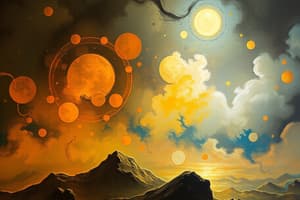Podcast
Questions and Answers
What is the primary definition of matter?
What is the primary definition of matter?
- An element that consists of a single type of atom
- A combination of different elements in a fixed ratio
- Anything that has weight regardless of its volume
- A physical substance that has mass and occupies space (correct)
Which of the following correctly describes isotopes?
Which of the following correctly describes isotopes?
- Isotopes have the same number of protons but a different number of neutrons. (correct)
- Isotopes are elements with the same mass number but different atomic numbers.
- All isotopes have identical chemical properties.
- Isotopes are different versions of the same element based on the number of protons.
How do you calculate the average atomic mass of chlorine with two isotopes?
How do you calculate the average atomic mass of chlorine with two isotopes?
- Multiply each isotope's mass number by its natural occurrence percentage, then sum those results. (correct)
- Use the formula: total mass number times the number of isotopes.
- Divide the sum of mass numbers by the number of isotopes.
- Take the average of the two isotopes' mass numbers directly.
What does the conservation of mass law state?
What does the conservation of mass law state?
In balancing a chemical equation, which atom should be balanced first?
In balancing a chemical equation, which atom should be balanced first?
What is the main purpose of stoichiometry in chemistry?
What is the main purpose of stoichiometry in chemistry?
Which of the following best describes limiting reagents?
Which of the following best describes limiting reagents?
How is the percent yield calculated in a chemical reaction?
How is the percent yield calculated in a chemical reaction?
Flashcards
Atom
Atom
A fundamental unit of matter, consisting of a dense central nucleus surrounded by a cloud of negatively charged electrons.
Atomic number
Atomic number
The number of protons in the nucleus of an atom. It determines the element to which the atom belongs.
Mass number
Mass number
The total number of protons and neutrons in the nucleus of an atom. It determines the mass of an atom.
Isotopes
Isotopes
Signup and view all the flashcards
Average atomic mass
Average atomic mass
Signup and view all the flashcards
Law of Conservation of Mass
Law of Conservation of Mass
Signup and view all the flashcards
Limiting reagent
Limiting reagent
Signup and view all the flashcards
Theoretical yield
Theoretical yield
Signup and view all the flashcards
Study Notes
SI System Units
- Length: meter
- Time: second
- Amount of substance: mole (mol)
- Electric current: ampere (amp)
- Temperature: Kelvin
- Mass: kilogram
Matter
- Matter is a physical substance with mass and occupies space.
Atomic Structure
- Atomic number: number of protons in an atom's nucleus
- The number of protons equals the number of electrons in a neutral atom.
- Atoms with the same number of protons are the same element.
- Atomic mass: sum of protons and neutrons in an atom.
- To find the number of neutrons, subtract the number of protons from the atomic mass.
Isotopes
- Isotopes are different versions of the same element.
- Isotopes have the same number of protons but a different number of neutrons.
- Isotope number: total number of protons and neutrons.
- Average atomic mass calculation: weighted average of the masses of different isotopes based on their natural abundance in percentage.
Conservation of Mass
- Matter cannot be created or destroyed in a chemical reaction.
- All atoms present in the reactants are present in the products, in some form.
- Small mass loss in chemical reactions is due to released energy.
Balancing Equations
- In chemical equations, balance the atoms on both sides of the equation to maintain conservation of mass.
- Balance the oxygen atoms first and then balance the other elements.
Limiting and Excess Reagents
- Limiting reagent determines the maximum amount of product. (Complete and balance the chemical equation, convert to moles)
- Use the mole ratio to calculate the moles of the product from the limiting reagent.
- Find the mass of the product.
Stoichiometry
- Mole to mole conversions: Use coefficients in balanced equations.
- Mole to mass conversions: Calculate product mass using molar mass.
Percent Yield
- Percent yield: actual yield/theoretical yield x 100%.
- Actual yield: experimentally obtained amount of product.
- Theoretical yield: maximum amount of product calculated.
Chemical Bonding
- Ionic compounds: solid at room temperature, formed between metals and nonmetals.
- Covalent compounds: formed between nonmetals, can be in any state (solid, liquid, gas).
Molecular Shapes
- Molecular shapes and bond angles are important aspects of covalent compounds. (Shape list given in the document)
Electronegativity/ Atomic Radius
- Electronegativity increases across a period and decreases down a group.
- Atomic Radius increases down a group and decreases across a period.
Ionic Radius and Ionization Energy
- Ionic radius of a cation is less than atomic radius.
- Ionic radius of an anion is greater than atomic radius.
- Ionization energy is the energy needed to remove an electron from a gaseous atom.
Electron Affinity
- Electron affinity is the energy released when an electron is added to a gaseous atom.
Gas Laws
- Charles' Law: volume varies directly with temperature at a constant pressure.
- Boyle's Law: pressure varies inversely with volume at a constant temperature.
Standard Temperature and Pressure (STP)
- Universal value of STP: 1 atm pressure and 0°C (convert to Kelvin).
- 1 mole of gas occupies 22.4 L at STP..
- Use Ideal Gas equation when amount of gas and mass are given.
Lewis Structures
- Lewis structures are used to represent molecules and polyatomic ions.
- Valence electron count.
- Determine number of bonds needed to complete the octet rule.
- Central atom.
- Skeletal structure.
- Place electrons outside the atoms.
Studying That Suits You
Use AI to generate personalized quizzes and flashcards to suit your learning preferences.




